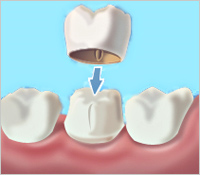Restore Your Smile with Crown and Bridge Services in Mount Waverley and the Surrounding Areas
Restore Your Smile with Crowns and Bridges
Crowns and Bridges are fixed prosthetic devices cemented onto existing teeth or implants by a dentist or prosthodontist (dental specialist). Crowns are commonly used to cover or “cap” a damaged tooth or restore an implant. Bridges are commonly used to cover a space if you are missing one or more teeth. They are cemented to natural teeth or implants surrounding the space where the tooth once stood.
How Do Crowns Work?
A crown entirely covers or “caps” a damaged tooth. Besides strengthening a damaged tooth, a crown can be used to improve its appearance, shape, or alignment. A crown can also be placed on top of an implant to provide a tooth-like shape and structure for function. Porcelain or ceramic crowns can be matched to the colour of your natural teeth. Other materials include gold and metal alloys, acrylic and ceramic. The alloys are generally stronger than porcelain and may be recommended for the back teeth. Porcelain bonded to a metal (PFM) shell is often used because it is both solid and cosmetic.
Your dentist may recommend a crown to:
- Replace a large filling when there is not enough tooth structure remaining
- Protect a weak tooth from fracturing
- Restore a fractured tooth
- Attach a bridge
- Cover a dental implant
- Cover a discoloured or poorly shaped tooth
- Cover a tooth that has had root canal treatment

How Do Bridges Work?
A bridge may be recommended if you are missing one or more teeth. Gaps left by missing teeth eventually cause the remaining teeth to rotate or shift into empty spaces, resulting in a bad bite. The imbalance caused by missing teeth can also lead to gum disease and temporomandibular joint (TMJD) disorders.
Bridges are commonly used to replace one or more missing teeth. They span the space where the teeth are missing. Bridges are cemented to the natural teeth or implants surrounding the area. These teeth, called abutments, serve as anchors for the bridge. A replacement tooth, called a pontic, is attached to the crowns that cover the abutments. As with crowns, you have a choice of materials for bridges. Your dentist can help you decide which to use based on the location of the missing tooth (or teeth), its function, aesthetic considerations, and cost. Porcelain or ceramic bridges can be matched to the colour of your natural teeth.
How Are Crowns and Bridges Made?
Two visits to your dentist will be required to prepare and fit a dental crown or bridge. The first appointment typically takes an hour.
The dentist will first administer local anaesthetic to the required tooth area to prepare the tooth for a dental crown. A dental crown sits over the top of an existing tooth. To do this without interrupting how your teeth bite, the tooth is shaped and cuts back to allow space for the crown to “cap” the tooth.
After reshaping the tooth, your dentist will use a paste or putty to make an impression of the tooth to receive the crown. Impressions of the teeth above and below the tooth to receive the dental crown will also be made to ensure that the crown will not affect your bite.
The impressions are sent to a dental lab to manufacture the crown. During this first visit, your dentist will make a temporary crown to cover and protect the prepared tooth while the crown is being made. Temporary crowns usually are made of acrylic and are held in place using temporary cement.
At the second visit, which is usually two weeks later, your dentist will remove the temporary crown and check the fit and shade of the permanent crown. If you are pleased with your new crown or bridge, your dentist will permanently cement it.

How Long Do Crowns and Bridges Last?
While crowns and bridges can last ten years or more, they sometimes become loose or fall out. The most crucial step to ensure the longevity of your crown or bridge is to practice good oral hygiene. A bridge can lose its support if the teeth or bone holding it in place are damaged by dental disease.
- Keep your gums and teeth healthy by brushing with fluoride toothpaste twice a day and flossing daily.
- Visit your dentist twice a year for oral health check-ups and cleanings
- To prevent damage to your new crown or bridge, avoid chewing hard foods, ice or biting other hard objects such as pens and fingernails.

Discuss your crown and bridge options and let us help you achieve a healthy and beautiful smile.
Quick Links
Contact Information
318 Highbury Road, Mount Waverley 3149
03 9808 1109
ABN: 86220409494
Business Hours
- Mon - Wed
- -
- Thursday
- -
- Friday
- -
- Saturday
- -
- Sunday
- Closed




